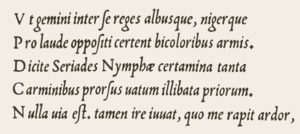
Ludovico Vicentino degli Arrighi
Encyclopedia

Scribe
A scribe is a person who writes books or documents by hand as a profession and helps the city keep track of its records. The profession, previously found in all literate cultures in some form, lost most of its importance and status with the advent of printing...
, and type designer in Renaissance
Renaissance
The Renaissance was a cultural movement that spanned roughly the 14th to the 17th century, beginning in Italy in the Late Middle Ages and later spreading to the rest of Europe. The term is also used more loosely to refer to the historical era, but since the changes of the Renaissance were not...
Italy
Italy
Italy , officially the Italian Republic languages]] under the European Charter for Regional or Minority Languages. In each of these, Italy's official name is as follows:;;;;;;;;), is a unitary parliamentary republic in South-Central Europe. To the north it borders France, Switzerland, Austria and...
.
Very little is known of the circumstances of his life. He may have started his career as a writing master in Venice, although this has been disputed.
Around 1510 he was a bookseller in Rome.
He was employed as a scribe at the Apostolic Chancery in 1515. His experience in calligraphy led him to create an influential pamphlet on handwriting in 1522 called La Operina, which was the first book devoted to writing the italic
Italic type
In typography, italic type is a cursive typeface based on a stylized form of calligraphic handwriting. Owing to the influence from calligraphy, such typefaces often slant slightly to the right. Different glyph shapes from roman type are also usually used—another influence from calligraphy...
script known as chancery
Chancery hand
The term "chancery hand" can refer to one of two very different styles of historical handwriting.A chancery hand was at first a form of handwriting for business transactions that developed in the Lateran chancelry of the thirteenth century, then spread to France, notably through the Avignon...
cursive.
This work, a 32-page woodblock
Woodcut
Woodcut—occasionally known as xylography—is a relief printing artistic technique in printmaking in which an image is carved into the surface of a block of wood, with the printing parts remaining level with the surface while the non-printing parts are removed, typically with gouges...
printing, was the first of several such publications.
He turned to printing in 1524 and designed his own italic typefaces for his work, which were widely emulated. His letterforms were revived in the 20th century by designers such as Stanley Morison
Stanley Morison
Stanley Morison was an English typographer, designer and historian of printing.Born in Wanstead, Essex, Morison spent most of his childhood and early adult years at the family home in Fairfax Road, Harringay...
, Frederic Warde
Frederic Warde
Frederic Warde was a typographic designer. He was born in Wells, Minnesota, enlisted in the United States Army in 1915 and attended the Army School of Military Aeronautics at the University of California, Berkeley during 1917-1918...
, Robert Slimbach
Robert Slimbach
Robert Slimbach is a type designer, who has worked at Adobe Systems since 1987. He has won many awards for his digital typeface designs, including the rarely-awarded Charles Peignot Award from the Association Typographique Internationale, and repeated TDC2 awards from the Type Directors Club.-...
(for example Adobe Jenson
Adobe Jenson
Adobe Jenson is an old style serif typeface drawn for Adobe Systems by type designer Robert Slimbach. Its Roman styles are based on a Venetian oldstyle text face cut by Nicolas Jenson in 1470, and its italics are based on those by Ludovico Vicentino degli Arrighi...
italic) and Jonathan Hoefler
Jonathan Hoefler
Jonathan Hoefler is an American typeface designer. Hoefler founded Hoefler & Frere-Jones , a type foundry in New York that Hoefler shares with fellow type designer Tobias Frere-Jones.Hoefler has designed original typefaces for Rolling Stone Magazine, Harper’s Bazaar, The New York Times Magazine,...
(in his Requiem Text typeface.) His last printing was dated shortly before the sack of Rome (1527)
Sack of Rome (1527)
The Sack of Rome on 6 May 1527 was a military event carried out by the mutinous troops of Charles V, Holy Roman Emperor in Rome, then part of the Papal States...
, during which he was probably killed.

